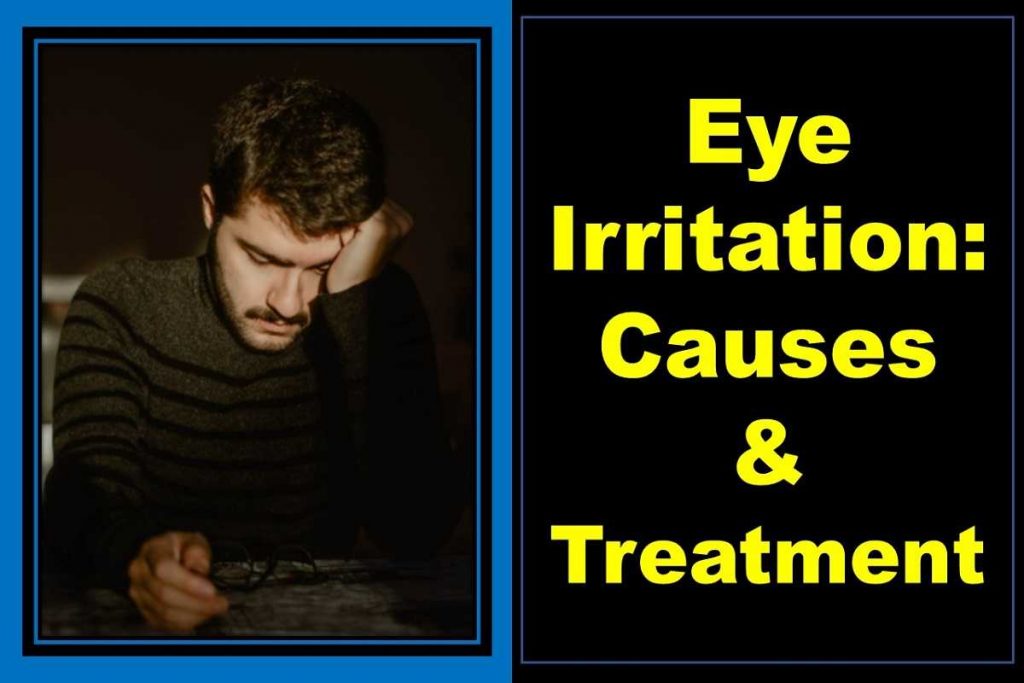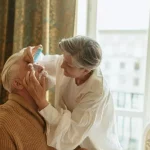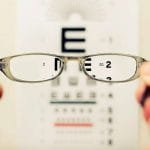Eye irritation is a common symptom that many people experience, including dryness, itchiness, pain, burning sensation, and grittiness. This can be caused by injuries, eye diseases like dry eye or conjunctivitis
One of the most common symptoms of eye irritation is dryness, which can occur either due to an insufficient quantity of tears or due to excessive evaporation. Along with dryness, itching, burning, and grittiness can also be a component of eye irritation.
This article details some common causes of irritated eyes. As always, it’s best to see an eye care professional whenever you experience this symptom.
Symptoms of Irritated Eyes
Different people will experience different symptoms depending on the source of their eye irritation. While there are a lot of potential symptoms, the most common are:
- eye itching that happens throughout the day and night
- watery eyes
- mild to moderate eye pain
- red eyes
- blurry vision
- increased light sensitivity

18 Causes of Eye Irritation
Dry Eyes
You may have dry eye syndrome if your eyes sting or feel dry and scratchy. This condition can be caused if the tear glands are not producing enough tears, or due to a lack of quality tears.
Dry eye syndrome is quite common. The problem becomes even more pronounced as we age. By the time you’re sixty-five, your eyes produce 65% fewer tears than when you were 18 years old.
lack of quality tears and moisture even leads to blurry vision and visual distortions.
Treatment and Home Remedies
Mild dry eye symptoms can be addressed by using over-the-counter artificial tears. More severe cases may require dry eye medication prescribed by your eye doctors.
Stopping smoking, cutting down on screen time, and wearing wraparound sun-protective sunglasses can reduce the symptoms of dry eye.
If you think you might have a dry eye disease, make sure to talk to a doctor about treatment. Prevention is key and the earlier you intervene, the less likely it will seep into more serious problems.
Eye Allergies
An eye allergy is a response to something you’re allergic to like pollen or dust in the eyes which can cause itchy and watery eyes.
Eye allergies can be a result of allergens such as pollen, dust mites, molds, and pet dander.
Typical allergy symptoms often occur in both eyes shortly after exposure to an allergen. For example, you may experience eye allergy symptoms if you visit the home of a relative who has pets like a cat or dog.
Treatment and Remedies
Although it might not be possible to permanently get rid of your eye allergies, it’s very important to prevent symptoms from happening in the first place. The best way to do this is by avoiding the things that trigger eye allergies.
One way to prevent pollens from making your eyes itchy and irritated is to stay inside or minimize the risk during times with the highest pollen in the air. Keeping windows closed and using high-quality air filters with an air conditioner also helps a lot.
Symptom relief is the main treatment for allergies. This can be achieved by taking over-the-counter pills or eye drops. However, if your allergy symptoms linger or persist, your doctor may prescribe you a prescription drug or allergy shots.
Irritants
Exposure to eye irritants such as eye makeup, sunscreen, tobacco smoke, chlorinated pool water, and the air around indoor pools can cause eye irritation, making them red and itchy.
If you have irritated eyes due to exposure to irritants, rinse your eyes with clean, warm water, and use lubricating eye drops to soothe them.
Foreign Bodies
Sand, dirt, and sawdust are serious irritants to your eyes. They can trigger the release of tears and irritate or scratch your cornea.
Symptoms of foreign objects inside your eyes include pain, redness, watering, and sensitivity to light.
Treatment
If you think a foreign object is in your eye, your doctor will use torchlight or some instruments (slit lamp) to try to find it. They may also look under your eyelid or use dye to check for scratches or abrasions on the cornea.
Treatment involves removing any foreign objects from your eye. You will also be prescribed a course of antibiotics to help prevent infection.
Computer Vision Syndrome
Digital eye strain or computer vision syndrome is a common problem that many people experience when they’ve been using computers, phones, or tablets for an extended period.
The symptoms of digital eye strain include feeling tired, dry, itchy, or irritated eyes, neck and back pain, and sometimes headaches.
Digital eye strain is a temporary issue and will go away as soon as you stop using your computer or phone.
The American Optometric Association recommends you follow the 20-20-20 rule when using your computer or other electronic devices. After using screens for 20 minutes, you should take at least 20 seconds to look at something more than 20 feet away before going back to work.
Contact Lens
If you wear contact lenses, never neglect to look after them lest they can make your eyes red or sore. Do not wear them when your eyes are irritated.
Follow the instructions your optometrist gave you for disinfecting and replacing your contacts. If you have dry eyes, ask your optometrist if it’s okay to try a different lens and/or wear them less often.
Eye Injuries
Eye injuries can cause several kinds of eye problems such as eye irritation, watering, pain, burning sensation, swelling, and blurry vision or sight loss in severe cases. Common causes of eye injury are accidentally splashing certain chemicals into the eyes, blow out injury, getting dust, sand, etc., inside the eyes.
Treatment and Remedies
Blinking might help to get sand or dirt particles out of your eye, but you can also try washing it with saline solution or running some cool water over the area.
Cold compression over the affected area of the eye helps to reduce pain and swelling if someone gets hit in the eye.
When someone’s eye is punctured or cut, they should cover it with a protective shield to ensure it’s not exposed to any contaminants. They should then go straight to the emergency room.
If someone accidentally gets a chemical in their eyes, they should wash it out with plenty of clean water, then head to the emergency room.
Conjunctivitis (Pink Eyes)
Conjunctivitis, or pink eye, is an inflammation of the conjunctiva. Conjunctiva is a clear membrane that lines the inside of the eyelid and covers part of the eyeball.
The first and most obvious symptom of pink eye is a red or “pink” colored eye. Blood vessels swell and that causes discoloration in the white of your eye.
The term “pink eye” can refer to a variety of types of conjunctivitis: bacterial, viral, fungal, and allergic.
Caused by either viruses, bacteria, or fungi, it might require different forms of treatment. A few examples include over-the-counter drugs, home remedies, and prescription medication.
The treatment of conjunctivitis or pink eye depends on the cause.
Viral conjunctivitis is easily passed from person to person, but a cool wet cloth placed over your eyes for about 10 minutes will often alleviate the symptoms. Over-the-counter eye drops can help those who experience intense symptoms.
Bacterial conjunctivitis is a non-contagious condition that can be treated with topical antibiotics.
Irritants such as pollen, animal hair, mold, or dust mite feces can give you symptoms of allergic conjunctivitis if they get in the eye. Allergic conjunctivitis may be uncomfortable but it is not dangerous. Over-the-counter anti-allergic eye drops from the drugstore can help you treat this condition.
Blocked Tear Duct (Nasolacrimal Duct Obstruction or NLDO)
Tears normally drain from your eye by running through the tear ducts (one tear duct in each eye). A blocked tear duct is a common condition that can cause eye irritation due to the accumulation of tears in the eyes.
Some additional symptoms of blocked tear duct include crusting of the eyelids and pain around the inner corner of your eye. Additionally, you may experience recurring conjunctivitis much more readily than usual.
Treatment and Remedies
There are various ways in which your doctor might help you with blocked tear ducts. They can widen your tear duct, place a small tube to drain tears, and sometimes surgery may be required to open a passage for tears.
In babies, lacrimal massage helps to open the blocked tear duct in more than 90 percent of the cases of NLDO.
Blepharitis
Blepharitis is an inflammation of the eyelid is caused by excess oil or meibomian gland dysfunction (bacterial infection). It causes red, crusty lids, usually along with eye irritation and discharge.
If you have blepharitis, there’s a chance that you’ll experience certain symptoms during the morning. You may notice flakes of debris, crusty particles on your pillow or stuck to your eyelashes.
This is a very common condition in adults and children alike. People with poor facial hygiene are often found to have also developed blepharitis because of the infection that is prevalent in their eyelids
Trichiasis
If the eyelashes grow in the opposite or wrong direction (inward), the condition is known as trichiasis. You may not see it if you look in the mirror but they may feel scratchy when they touch your eye with every blink of your eyelids.
This sounds simple but it can be very harmful to your eye, especially the cornea, the clear front structure of your eyes. The treatment is to just remove the offending eyelash which may grow back, though.
Corneal Ulcer
A corneal ulcer is a sore that forms on the surface of the cornea of the eye. These sores are common among people who wear contacts, and it’s more common for people who sleep while wearing their contact lenses.
The most common symptom of the corneal ulcer is intense pain, followed by sensitivity to light, and redness of the eye. Some people with ulcers may experience irritated eyes in a constant way.
Pinguecula and Pterygium
A pinguecula is often called the “surfer’s eye,” and it is a tiny benign growth on the nasal or temporal side of the white part of the eye. It often starts out as a small yellow patch, but can gradually grow larger over time.
If your pinguecula (pigment spot on the eye) continues to grow larger, it may eventually become an issue and turn into a pterygium. They can cover almost half of the surface area of your cornea in extreme cases.
The growths are caused by your exposure to UV radiation. Preventing them with a good pair of sunglasses and goggles can be easy.
This is not a serious eye condition, but if it causes a burning sensation, eye irritation, or if it affects your vision, you will need treatment. The most common form of treatment for this type of condition is lubricating eyedrops. The advanced pterygium needs to be excised or removed with minor surgery.
Chalazion and Stye
If you have a chalazion (a small, painless bump at the eyelid) or a style (small, painful lump on the edge of your eye), it can cause you to experience eye irritation.
A stye may look like a pimple and often also causes swelling. You may also notice pain around your eye.
Stye and chalazion usually disappear on their own and warm compresses can often help. Persistent chalazion and stye may be treated with prescription antibiotics or surgery to drain pus.
Subconjunctival Hemorrhage
One of the most common symptoms of a broken blood vessel in your eye or a subconjunctival hemorrhage is a bright red patch on the white part of your eye.
If you don’t experience any pain or discharge with a subconjunctival hemorrhage, this type of eyesore shouldn’t bring any noticeable change to your vision. You may feel eye irritation or other discomforts due to the blood accumulation though.
Ocular Rosacea
A common symptom of rosacea, a chronic skin condition that can affect various parts of the body, is eye irritation. The eyes are dry, itchy, and red due to inflammation on the eyelids.
Rheumatoid Arthritis
Rheumatoid arthritis is an autoimmune disorder prohibiting the immune system to distinguish between self and foreign matter. This may lead to noticeable dryness in the membranes of different joints. One of these areas is the conjunctiva membrane in one’s eyes.
The drying of your eyes will make them very uncomfortable, leading to a painful burning sensation, and eye irritation.
Takeaway
Red, itchy, sore, and irritated eyes are never a comfortable feeling. There are some causes of these symptoms that are more serious than others.
These causes can be temporary, such as digital eye strain that could subside on its own, or persist and require treatment. For example, you might have a stye, or blocked tear duct that requires medical care to treat the specific cause.
It’s tough to predict the type of treatment. Each case and symptom will be different, but there are plenty of treatment and medication options available.
The type of treatment that you receive is dependent on what’s causing your eye irritation and can range from medicated eye drops to surgical procedures.
It’s important to see your doctor or an eye specialist to find the reason for irritated eyes and get your eye problem properly treated.










